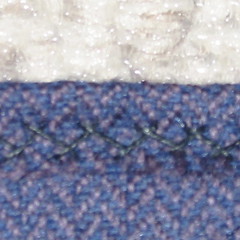The write-up for the Hedeby find lists herringbone stitch as being used to finish the top edge, and I've done likewise, as shown here. It's a slightly unusual choice, as herringbone is more typically done as a decorative stitch or in simple embroidery. Thinking about it, though, it should be a fairly effective way of finishing a single-fold edge. Because of the stitch's zig-zag pattern, the weave is held together both along and across the grain. I'll see how effective it is in practice, although my fabric isn't likely to fray in the first place.
The write-up isn't particularly clear about whether the stitch faces in or out; I've chosen to have what is normally the face of the stitch on the inside of the garment, right on the raw edge. The backside of the stitch looks like two rows of running stitch, and is nearly invisible on the exterior of the dress (picture here).
Subscribe to:
Post Comments (Atom)

1 comment:
H, Catrijn! I followed links to your blog from a post you made on Medcos, and found that you were making a Viking apron dress! I'm impressed with your work, and I hope that when you have the dress done you'll be interested in putting a picture in the Early Period photo gallery on MedCos (I'm the Early Period moderator).
--Cathy Raymond
Post a Comment